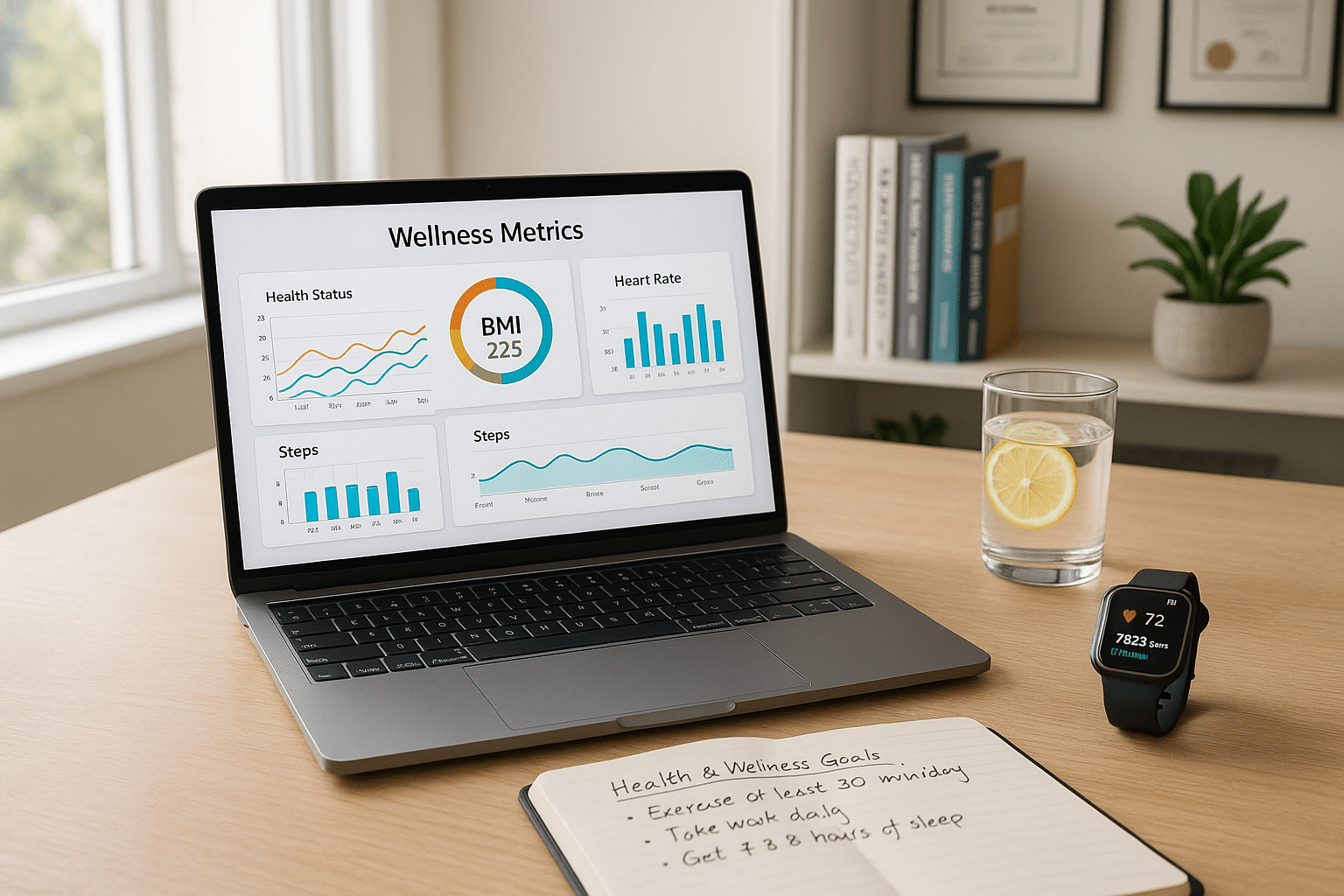🌍🏃♀️📊 If you have ever asked yourself how to truly quantify and monitor your wellness journey, you’ve landed in the right place. Welcome to a comprehensive dive into the ocean of wellness metrics and their significance in amplifying our health outcomes.
The era of treating health and wellness as separate entities is long gone. Today, wellness is seen as an active pursuit that goes beyond mere freedom from disease. It encompasses mental, physical, and social aspects of life. But how do we know if we are truly achieving wellness? Enter wellness metrics. These data-driven indicators not only provide a snapshot of our current health status but also forecast potential risks. Armed with this knowledge, we can create personalized wellness plans that yield meaningful and sustainable results. 💪🏼📈
Before diving deeper, let’s demystify the term ‘wellness metrics.’ Wellness metrics are quantifiable measures of various health and well-being parameters. These include, but are not limited to, physical attributes like body mass index (BMI), resting heart rate, and blood pressure. They also cover psychological and social dimensions like stress levels, work-life balance, and social connections. By regularly tracking these metrics, we can maintain an optimal wellness balance and preempt potential health issues.
In this blog post, we’ll explore the most pertinent wellness metrics that can make a real difference in our lives. We’ll elucidate their significance, methods to measure them, and strategies to optimize these metrics for maximum health benefits. So, whether you’re a fitness enthusiast, a health-conscious individual, or a wellness professional, this guide has something beneficial for you. 👩⚕️👨💻
🔍 What to Expect?
We’ll commence our journey with physical wellness metrics like BMI, body fat percentage, and resting heart rate. As we navigate through these metrics, we’ll understand their importance, examine the best ways to measure them, and learn how to interpret the results. We’ll also explore how small lifestyle adjustments can lead to significant improvements in these parameters.
Next, we’ll delve into emotional and psychological wellness metrics. We’ll dissect metrics like stress levels and work-life balance, unravel their impact on our overall wellness, and discuss strategies to manage and optimize them. We’ll also understand why these often overlooked metrics are as crucial as their physical counterparts.
Finally, we’ll look at the social aspect of wellness, examining metrics like social connections and community involvement. We’ll understand why humans, as social beings, need to prioritize these metrics for a holistic wellness approach.
So, are you ready to embark on this enlightening journey into the world of wellness metrics? Buckle up, as we explore the intricacies of these measures and discover how you can leverage them to maximize your health and wellness results.
Let’s dive right in! 🏊♀️📚
🔍 Understanding the Importance of Tracking Wellness Metrics
The growing popularity of wearable technology has revolutionized how we approach health and wellness. Instead of relying on annual check-ups for a snapshot of our health, we now have the power to continuously monitor critical wellness metrics in real time, giving us unprecedented control over our well-being.
But with the availability of various tracking devices and an array of metrics to choose from, it’s essential to know which ones are truly significant and can yield meaningful insights into our health. In this article, we will delve into the world of wellness metrics, demystifying the most crucial ones that you should be tracking to maximize your health outcomes.
We’ll also explore how to interpret these metrics effectively and apply the insights in your wellness journey. Let’s get started!
🧬 Key Wellness Metrics Worth Your Attention
While there are countless wellness metrics that you could track, not all of them provide equal value. Certain metrics are far more indicative of your overall health status than others. Let’s delve into some of these essential metrics.
1. Heart Rate
Heart rate is a fundamental wellness metric that provides insights into your cardiovascular health. It is measured as beats per minute (BPM) and varies depending on factors such as age, fitness level, and activity state.
2. Blood Pressure
Regularly monitoring blood pressure can help detect hypertension, a silent killer that often goes unnoticed until it causes severe health problems. Normal blood pressure is below 120/80 mm Hg.
3. Sleep Duration and Quality
Sleep is a critical wellness metric as it affects all areas of our health. Tracking sleep duration and quality can provide insights into your overall wellness and potential health risks.
For a visual comparison of these wellness metrics, have a look at the table below:
| Wellness Metric | Description | Normal Range |
|---|---|---|
| Heart Rate | Number of heart beats per minute | 60-100 BPM at rest |
| Blood Pressure | Pressure of blood in circulatory system | Below 120/80 mm Hg |
| Sleep Duration and Quality | Length and quality of sleep | 7-9 hours of good quality sleep per night |
For a more detailed discussion on these wellness metrics, check out this video: “Wellness Metrics Explained” by Dr. Mike Evans on YouTube.
🔬 Interpreting and Applying Wellness Metrics
Knowing your wellness metrics is just half the battle. The real value lies in effectively interpreting these numbers and using them to make informed health decisions. Here’s how you can do that:
1. Understand Your Baseline
Your baseline is your normal range for any given metric when you’re healthy. Knowing your baseline allows you to spot any abnormal changes and address potential health issues early on.
2. Spot Trends Over Time
Instead of focusing on isolated readings, look at your metrics over time to spot trends. This can help you understand how your lifestyle habits are affecting your health.
3. Consult with Health Professionals
While self-monitoring is beneficial, it is crucial to consult with health professionals for expert interpretation of your metrics and personalized advice.
For more insights on how to interpret and apply wellness metrics, watch the video: “Interpreting Your Health Data” by Healthcare Triage on YouTube.
💡 Maximizing Results: Tools and Techniques for Effective Wellness Tracking
Now that we’ve covered the importance of tracking wellness metrics and how to interpret them let’s discuss some of the tools and techniques that can help you effectively monitor your health.
1. Wearable Technology
From fitness bands to smartwatches, wearable technology has made it incredibly easy to track wellness metrics continuously. Devices like the Fitbit, Apple Watch, and Garmin offer features that allow you to monitor everything from heart rate and blood pressure to sleep quality and stress levels.
2. Health Apps
There are numerous health apps available that can connect with your wearables and provide a comprehensive view of your wellness metrics. Apps like MyFitnessPal, Headspace, and SleepCycle can help you monitor your nutrition, mental health, and sleep, respectively.
3. Regular Health Check-ups
Despite the rise of digital health tracking, regular health check-ups with your doctor are still essential. They provide a more comprehensive view of your health and help detect any potential issues early on.
For a more detailed discussion on the use of technology for wellness tracking, watch the video: “The Future of Personalized Health Monitoring” by TEDx Talks on YouTube.
Tracking wellness metrics is not just a trend; it’s a fundamental shift in how we approach health and wellness. With the right metrics and tools, you can gain valuable insights into your health and make informed decisions that lead to improved wellness. Start tracking your wellness metrics today and take control of your health!

Conclusion
To conclude, the journey of this informative article has taken us through the various aspects of the selected subject matter. We explored the intricate concepts of software engineering and the significance of technical writing in such a domain. Like the pieces of a complex jigsaw puzzle, each point is important and has its place in the grand scheme of things.🧩
We began by discussing the definition of software engineering, its relevance in today’s digital world, and how it is the backbone of the technological advancements we see around us. It was established that software engineering is not merely about coding, but involves a systematic and disciplined approach to software development. We then delved into the role of a technical writer in the field of software engineering and how the ability to articulate complex concepts in a comprehensible manner is a sought-after skill.
We further highlighted the importance of good technical writing for effective communication among teams, as well as in making complex software understandable for the end users. It was brought to the fore that well-written technical documents not only help in software development but also play a crucial role in software testing and maintenance.
The article also emphasized the importance of clarity, conciseness, and accuracy in technical writing. By using relevant examples, we explained how these qualities can enhance understanding and reduce ambiguity. Moreover, we also touched upon how staying updated with the latest trends in software engineering can help technical writers create more relevant and valuable content.
The concluding part of the article focused on the challenges faced by technical writers in the field of software engineering. It was underscored that these challenges are opportunities for growth and improvement.
In retrospect, we have seen that software engineering and technical writing go hand-in-hand and are indispensable in the IT world. 🌐
I hope this comprehensive look into the intersection of software engineering and technical writing has been insightful for you. If you found this information useful, feel free to comment and share it with your colleagues or on your professional networks.
Moreover, if you’re a software engineer or a technical writer, don’t hesitate to apply the points mentioned in the article. Remember, the key to mastery is continuous learning and application. 👨💻👩💻
To dive deeper into this subject, you can refer to sources such as [ScienceDirect], [IEEE Xplore], and [Springer’s Journal of Software and Systems Modeling].
Thank you for accompanying me in this enlightening journey. I look forward to exploring more such stimulating topics in the realm of software engineering and technical writing in the future. Stay tuned and keep learning!🚀
References
1. ScienceDirect. (2018). An empirical study on the importance of technical writing skills for software industry professionals. [Link].
2. IEEE Xplore. (2017). The importance of good communication in software development teams. [Link].
3. Springer’s Journal of Software and Systems Modeling. (2021). Software Engineering: An overview. [Link].



